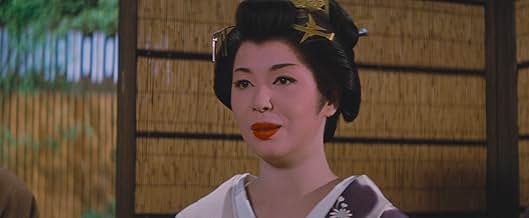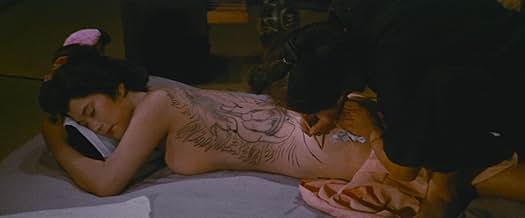IMDb RATING
6.1/10
771
YOUR RATING
Three tales of punishment and torture set in Japan in the Middle Ages.Three tales of punishment and torture set in Japan in the Middle Ages.Three tales of punishment and torture set in Japan in the Middle Ages.
Tôru Yuri
- Bath Owner
- (uncredited)
- Director
- Writer
- All cast & crew
- Production, box office & more at IMDbPro
Storyline
Did you know
- ConnectionsFollowed by Tokugawa onna keibatsu-emaki: Ushi-zaki no kei (1976)
Featured review
Shogun's Joy of Torture sees a change in direction for director Teruo Ishii, who leaves his previous cinematic worlds of gritty crime drama and cheesy sci-fi for more exploitative territory, where the order of the day is bondage, sadism, sex and tattoos. Yes... tattoos.
The film - which is set during the Edo period - opens with some truly eye-opening violence: a woman is hung from a tree, beheaded, and her body cut in half by a swordsman; another victim is burnt alive; and a lady is torn to pieces by horses. All of this before the opening credits have even finished. The rest of the film comprises of three tales of cruel punishment meted out for different crimes, while a Shogunate assistant weighs up the pros and cons of such extreme discipline.
The first story sees pretty 18-year-old Mitsu (Masumi Tachibana) forced to accept financial help from Minosuke (Kichijirô Ueda), master of the local kimono shop, after a log falls on her brother Shinzô, leaving him in need of expensive medical care. Indebted to Minosuke, Mitsu is forced to comply with his sexual demands, which leaves Shinzô distraught, for he has long harboured incestuous desires for his sister. Unable to bear it any longer, Shinzô declares his love for Mitsu, and is happy to learn that she feels the same way. The siblings begin a sexual relationship, but their taboo trysts are soon rumbled by Minosuke, who rapes Mitsu, knowing that they dare not report him. When Shinzô commits suicide in order to put an end to his shameful life, Mitsu loses her temper and attacks Minosuke, who finally reports the girl to the authorities. In order to get Mitsu to confess, she is stripped, bound, and beaten with bamboo. Mitsu doesn't break, and is given the option of exile instead of death, but the young woman ultimately decides that she would rather be reunited with her dead brother and confesses. Her punishment is to be crucified on an inverted cross in the surf as the tide comes in. Glub, glub, glub! Mitsu's fate is made all the more harrowing after we learn that Minosuke was responsible for Shinzô's injuries in the first place, having arranged for the accident so that he could have his way with Mitsu. Naughty naughty.
The next chapter is called 'The Beheading of an Abbess in the Juko Temple'. Mother Reiho (Yukie Kagawa) takes a fancy to bald priest Syunkai (Shin'ichirô Hayashi), who she discovers is having a secret affair with pretty (but equally as bald) nun Myôshin (Miki Obana). After watching the couple going at it in the woods, Reiho approaches Syunkai and orders him to strip and purify himself under a waterfall. While the young priest is repenting for his sins, Reiho slips out of her habit and joins him and they have sex. Afterwards, Syunkai tells Reiho he only jumped her to save Myôshin, for now she is just as guilty. His ploy doesn't work: Reiho has Myôshin tied up and tortured, using loaches and a red hot chili pepper to bring tears to her eyes (and I'm not talking about Flea wearing nothing but a sock - that would be way too cruel!). Syunkai turns up demanding to see Myôshin, and stupidly agrees to be tied up beforehand, which ultimately leads to the guy having his head hacked off by the now certifiably insane Reiho. The Shogunate officials turn up to find the crazy nun carrying the priest's head. She commits harakiri, but that doesn't stop the authorities crucifying her dead body and piercing it with spears, along with a handful of other, very much alive nuns.
The third story is the murder case of tattoo artist Horicho (Asao Koike), who is committed to producing a masterpiece depicting the agony of torture. When his latest work is mocked by a Shogunate lord for its lack of realism, Horicho finds a new canvas - a woman named Hana (Reiko Mikasa) who he kidnaps for her perfect skin - and sets about creating his finest work of art. Horicho requests if he can attend the torture of prisoners, so he can accurately capture their expressions, as well as using the sadistic lord as his model for a hellish ogre. However, the tattooist's real aim is to give the torturer a taste of his own medicine.
All three stories feature copious scenes of torture and misogyny which undeniably push the boundaries for the time, but never quite live up to the promise of the amazingly gory opening credits executions. However, those who think that this one doesn't go far enough should definitely check out the 1976 unofficial sequel, The Joy of Torture 2: Oxen Split Torturing, which goes all out to shock with its nasty graphic violence.
The film - which is set during the Edo period - opens with some truly eye-opening violence: a woman is hung from a tree, beheaded, and her body cut in half by a swordsman; another victim is burnt alive; and a lady is torn to pieces by horses. All of this before the opening credits have even finished. The rest of the film comprises of three tales of cruel punishment meted out for different crimes, while a Shogunate assistant weighs up the pros and cons of such extreme discipline.
The first story sees pretty 18-year-old Mitsu (Masumi Tachibana) forced to accept financial help from Minosuke (Kichijirô Ueda), master of the local kimono shop, after a log falls on her brother Shinzô, leaving him in need of expensive medical care. Indebted to Minosuke, Mitsu is forced to comply with his sexual demands, which leaves Shinzô distraught, for he has long harboured incestuous desires for his sister. Unable to bear it any longer, Shinzô declares his love for Mitsu, and is happy to learn that she feels the same way. The siblings begin a sexual relationship, but their taboo trysts are soon rumbled by Minosuke, who rapes Mitsu, knowing that they dare not report him. When Shinzô commits suicide in order to put an end to his shameful life, Mitsu loses her temper and attacks Minosuke, who finally reports the girl to the authorities. In order to get Mitsu to confess, she is stripped, bound, and beaten with bamboo. Mitsu doesn't break, and is given the option of exile instead of death, but the young woman ultimately decides that she would rather be reunited with her dead brother and confesses. Her punishment is to be crucified on an inverted cross in the surf as the tide comes in. Glub, glub, glub! Mitsu's fate is made all the more harrowing after we learn that Minosuke was responsible for Shinzô's injuries in the first place, having arranged for the accident so that he could have his way with Mitsu. Naughty naughty.
The next chapter is called 'The Beheading of an Abbess in the Juko Temple'. Mother Reiho (Yukie Kagawa) takes a fancy to bald priest Syunkai (Shin'ichirô Hayashi), who she discovers is having a secret affair with pretty (but equally as bald) nun Myôshin (Miki Obana). After watching the couple going at it in the woods, Reiho approaches Syunkai and orders him to strip and purify himself under a waterfall. While the young priest is repenting for his sins, Reiho slips out of her habit and joins him and they have sex. Afterwards, Syunkai tells Reiho he only jumped her to save Myôshin, for now she is just as guilty. His ploy doesn't work: Reiho has Myôshin tied up and tortured, using loaches and a red hot chili pepper to bring tears to her eyes (and I'm not talking about Flea wearing nothing but a sock - that would be way too cruel!). Syunkai turns up demanding to see Myôshin, and stupidly agrees to be tied up beforehand, which ultimately leads to the guy having his head hacked off by the now certifiably insane Reiho. The Shogunate officials turn up to find the crazy nun carrying the priest's head. She commits harakiri, but that doesn't stop the authorities crucifying her dead body and piercing it with spears, along with a handful of other, very much alive nuns.
The third story is the murder case of tattoo artist Horicho (Asao Koike), who is committed to producing a masterpiece depicting the agony of torture. When his latest work is mocked by a Shogunate lord for its lack of realism, Horicho finds a new canvas - a woman named Hana (Reiko Mikasa) who he kidnaps for her perfect skin - and sets about creating his finest work of art. Horicho requests if he can attend the torture of prisoners, so he can accurately capture their expressions, as well as using the sadistic lord as his model for a hellish ogre. However, the tattooist's real aim is to give the torturer a taste of his own medicine.
All three stories feature copious scenes of torture and misogyny which undeniably push the boundaries for the time, but never quite live up to the promise of the amazingly gory opening credits executions. However, those who think that this one doesn't go far enough should definitely check out the 1976 unofficial sequel, The Joy of Torture 2: Oxen Split Torturing, which goes all out to shock with its nasty graphic violence.
- BA_Harrison
- Jul 3, 2021
- Permalink
- How long is Shogun's Joy of Torture?Powered by Alexa
Details
- Release date
- Country of origin
- Language
- Also known as
- Female Punishment of the Tokugawa
- Production company
- See more company credits at IMDbPro
- Runtime1 hour 36 minutes
- Sound mix
- Aspect ratio
- 2.35 : 1
Contribute to this page
Suggest an edit or add missing content

Top Gap
By what name was Shogun's Joy of Torture (1968) officially released in India in English?
Answer























